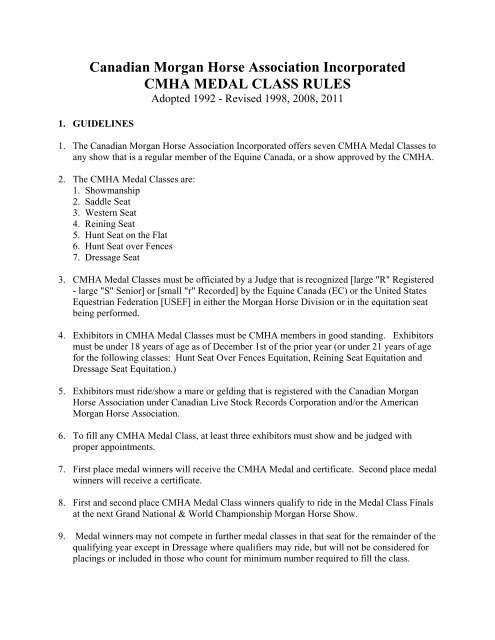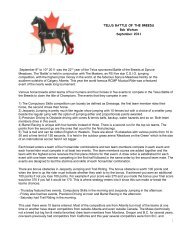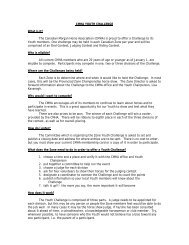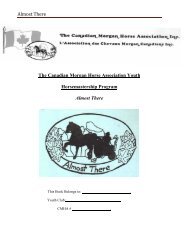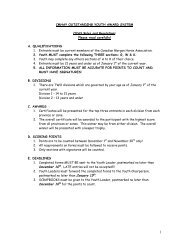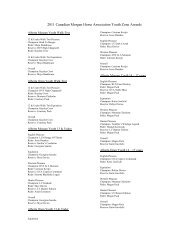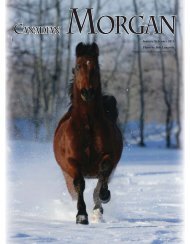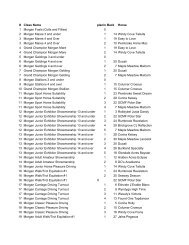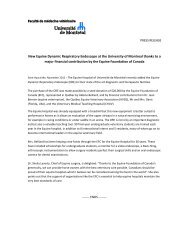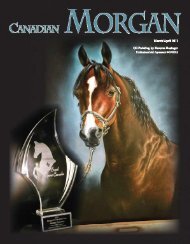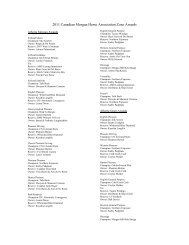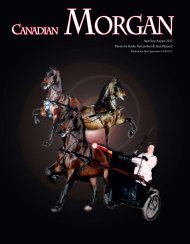Canadian Morgan Horse Association Incorporated CMHA MEDAL CLASS RULES
CMHAY Medal Class Rules - Canadian Morgan Horse Association
CMHAY Medal Class Rules - Canadian Morgan Horse Association
Create successful ePaper yourself
Turn your PDF publications into a flip-book with our unique Google optimized e-Paper software.
<strong>Canadian</strong> <strong>Morgan</strong> <strong>Horse</strong> <strong>Association</strong> <strong>Incorporated</strong><br />
<strong>CMHA</strong> <strong>MEDAL</strong> <strong>CLASS</strong> <strong>RULES</strong><br />
Adopted 1992 - Revised 1998, 2008, 2011<br />
1. GUIDELINES<br />
1. The <strong>Canadian</strong> <strong>Morgan</strong> <strong>Horse</strong> <strong>Association</strong> <strong>Incorporated</strong> offers seven <strong>CMHA</strong> Medal Classes to<br />
any show that is a regular member of the Equine Canada, or a show approved by the <strong>CMHA</strong>.<br />
2. The <strong>CMHA</strong> Medal Classes are:<br />
1. Showmanship<br />
2. Saddle Seat<br />
3. Western Seat<br />
4. Reining Seat<br />
5. Hunt Seat on the Flat<br />
6. Hunt Seat over Fences<br />
7. Dressage Seat<br />
3. <strong>CMHA</strong> Medal Classes must be officiated by a Judge that is recognized [large "R" Registered<br />
- large "S" Senior] or [small "r" Recorded] by the Equine Canada (EC) or the United States<br />
Equestrian Federation [USEF] in either the <strong>Morgan</strong> <strong>Horse</strong> Division or in the equitation seat<br />
being performed.<br />
4. Exhibitors in <strong>CMHA</strong> Medal Classes must be <strong>CMHA</strong> members in good standing. Exhibitors<br />
must be under 18 years of age as of December 1st of the prior year (or under 21 years of age<br />
for the following classes: Hunt Seat Over Fences Equitation, Reining Seat Equitation and<br />
Dressage Seat Equitation.)<br />
5. Exhibitors must ride/show a mare or gelding that is registered with the <strong>Canadian</strong> <strong>Morgan</strong><br />
<strong>Horse</strong> <strong>Association</strong> under <strong>Canadian</strong> Live Stock Records Corporation and/or the American<br />
<strong>Morgan</strong> <strong>Horse</strong> <strong>Association</strong>.<br />
6. To fill any <strong>CMHA</strong> Medal Class, at least three exhibitors must show and be judged with<br />
proper appointments.<br />
7. First place medal winners will receive the <strong>CMHA</strong> Medal and certificate. Second place medal<br />
winners will receive a certificate.<br />
8. First and second place <strong>CMHA</strong> Medal Class winners qualify to ride in the Medal Class Finals<br />
at the next Grand National & World Championship <strong>Morgan</strong> <strong>Horse</strong> Show.<br />
9. Medal winners may not compete in further medal classes in that seat for the remainder of the<br />
qualifying year except in Dressage where qualifiers may ride, but will not be considered for<br />
placings or included in those who count for minimum number required to fill the class.
10. <strong>CMHA</strong> Medal Class rules take precedence over Equine Canada or United States Equestrian<br />
Federation rules.<br />
2. PROCEDURES IN HOLDING <strong>CMHA</strong> <strong>MEDAL</strong> <strong>CLASS</strong>ES<br />
1. The show shall apply in writing to the <strong>CMHA</strong> Office, Box 286, Port Perry, Ontario L9L 1A3<br />
prior to the publication of the prize list. Permission to hold a <strong>CMHA</strong> Medal Class will not be<br />
granted to more than one show at the same location on a particular weekend.<br />
2. Prize lists must refer to the <strong>CMHA</strong> Medal Class specifications outlined in this document.<br />
3. The show secretary must verify that all entries in Medal Classes are current members of the<br />
<strong>CMHA</strong>. <strong>CMHA</strong> Membership numbers must be included on the Medal Class Report Form.<br />
Exhibitors may join <strong>CMHA</strong> by completing a membership application and submitting their<br />
membership fee to the show secretary prior to the class. The fee should be forwarded to<br />
<strong>CMHA</strong> with the name, address and birthdate of the new member.<br />
4. Before the show begins, the show manager should check with the Judge and Steward to make<br />
sure they have a copy of the <strong>CMHA</strong> Medal Class rules.<br />
5. Post entries may be accepted if the prize list so states.<br />
6. When additional tests are desired, the Judge's instructions to exhibitors shall be publicly<br />
announced. It is suggested that the Judge go over these instructions with the announcer<br />
immediately before they are announced to ensure mutual understanding of the wording.<br />
Judges shall NOT confer with exhibitors individually during the line-up. Individual workout<br />
instructions may be posted for all competitors to study, at least one hour before the session<br />
containing the class, and, if so, announced to the exhibitors.<br />
7. Shows offering <strong>CMHA</strong> Medal Classes are requested, but not required, to offer two additional<br />
equitation classes in each seat.<br />
8. The show secretary must complete the <strong>CMHA</strong> Medal Class Report Form and send it to the<br />
<strong>CMHA</strong> Office, Box 286, Port Perry, Ontario L9L 1A3 WITHIN TEN DAYS of the last day<br />
of the show.<br />
3. AMHA <strong>MEDAL</strong> <strong>CLASS</strong> FINALS<br />
1. All first or second place <strong>CMHA</strong> Silver Medal Class winners qualify to ride in the Gold<br />
Medal Class Finals at the next Grand National & World Championship <strong>Morgan</strong> <strong>Horse</strong> Show,<br />
providing the age eligibility requirement is met and all riders are current AMHA members.<br />
Classes won at shows held after the Grand National & World Championship <strong>Morgan</strong> <strong>Horse</strong><br />
Show will count toward the next year. Exhibitors who lose their age grouping are eligible to<br />
compete in the Medal Class Finals the following year.
2. Judges for all AMHA Medal Class Finals must be recognized by the EC or USEF as a<br />
Registered [large "R"/Senior] Judge in that seat.<br />
3. The winner of a Medal Class Final is no longer eligible to compete in the medal class that he<br />
or she has won.<br />
5. A rider need not ride the horse on which he qualified but may not use a horse in the Dressage<br />
Medal Finals that has competed above the Third Level [EC Medium II].<br />
6. In the Finals, the class must be worked on the rail in groups of 20 or less, and all contestants<br />
are required to perform an individual workout. If necessary, preliminary classes will be<br />
held with ALL riders performing an individual workout. A group of finalists will be chosen<br />
to compete in the final ride-off. At least SIX riders in the final ride-off will be required to<br />
perform an individual workout.<br />
7. The Judge must approve the course design for the Hunt Seat over Fences Medal Finals which<br />
must be posted one hour before the class. Obstacles used must conform to those outlined in<br />
the Hunter Division.<br />
8. In the Dressage Medal Finals, a ride-off will be required for first place if 5 points or less<br />
divide the highest and next highest score.<br />
9. If an equitation horse is incapacitated in the preliminary or before the ride-off, a substitution<br />
will be permitted upon examination of the incapacitated horse by a show Veterinarian and a<br />
Judge or a Steward.<br />
4. JUDGING REQUIREMENTS FOR ALL SEATS<br />
1. In equitation classes, only the rider/exhibitor is being judged, therefore, any horse which is<br />
suitable for a particular style of riding and is capable of performing the required class routine<br />
is acceptable. STALLIONS ARE PROHIBITED.<br />
2. In Hunt Seat, Western Seat and Stock Seat classes, the fall of horse or rider shall eliminate<br />
the entry. If the fall [or three disobediences in over fence classes] occurs during a ride-off,<br />
the contestant shall be placed last of those chosen for the ride-off. In Saddle Seat classes, the<br />
fall of horse or rider shall not necessarily eliminate the rider but may be penalized at the<br />
Judge's discretion. For Western Seat and Stock Seat classes, see chart in the appropriate<br />
section.<br />
3. Any rider/handler not having his mount under sufficient control shall be dismissed from the<br />
ring and shall be disqualified from the class.<br />
4. Riders must remain on the same mount throughout all phases of an equitation class until the<br />
Judge requests a change.
5. No rider shall be asked to perform a test on another mount before he has performed the same<br />
test on his own.<br />
6. No attendant shall be allowed in the ring except at the request of the Judge.<br />
7. Protective headgear with harness is optional and will not be discriminated against by the<br />
Judge.<br />
8. In Dressage Seat, Reining Seat and Hunter Seat Over Fences Medal classes, participants may<br />
compete in the Silver and Gold Medal classes under the shoeing and event guidelines of their<br />
respective disciplines. In all Medal classes including the above and also including the Saddle<br />
Seat, Hunt Seat On The Flat and Western Seat medal, horses may be shown in <strong>Morgan</strong><br />
competitions in the same shoes with which they compete in classes governed by the EC<br />
equitation division.<br />
9. For the Silver Medal to be awarded in the Showmanship, Saddle Seat, Western Seat, Hunter<br />
Seat on the Flat, Dressage Seat, Reining Seat, and Hunter Seat over Fences Medal Classes,<br />
exhibitor(s) with proper appointments must show and be judged. Riders must qualify for the<br />
Grand National Gold Medal Class in Saddle Seat, Western Seat, or Hunter Seat on the Flat<br />
at competitions licensed by The Federation or Equine Canada for competitions held within<br />
the United States and Canada or by AMHA for competitions held outside of the United<br />
States and Canada.<br />
10. In Dressage Seat, riders can qualify for the Grand National Gold Medal Class by riding<br />
a registered <strong>Morgan</strong> in an open Federation Dressage competition and earning a score of<br />
60% or higher in Training Level, Test Four. A copy of the test, including name of<br />
competition,<br />
the score and the judges signature, must be sent to the AMHA office by the rider prior to the<br />
Grand National entry deadline.<br />
11. In Reining Seat, riders may qualify for the Grand National Gold Medal Class by riding a<br />
registered <strong>Morgan</strong> in an open Federation or NRHA recognized competition and receiving a<br />
score of 70 points or higher in reining or a first-, second- or third-place in Reining Seat<br />
equitation.<br />
A copy of the prize list and proof of the score or placing must be signed by the<br />
Competition Secretary and submitted to the AMHA office by the rider prior to the Grand<br />
National entry deadline.<br />
12. In Hunter Seat Over Fences, riders may qualify for the Grand National Gold Medal<br />
Class by riding a registered <strong>Morgan</strong> in an open Federation Hunter over Fences Equitation<br />
class and placing first, second or third. A prize list and proof of placing signed by the<br />
Competition Secretary must be submitted to the AMHA office by the rider prior to the Grand<br />
National entry deadline.<br />
13. Silver Medal winners may not compete in further medal classes in that seat for the<br />
remainder of the qualifying year, except in Dressage Seat where qualifiers may ride, but will<br />
not be considered for placing or included in those who count for minimum number required<br />
to fill the class.
5. <strong>CMHA</strong> <strong>MEDAL</strong> <strong>CLASS</strong> SPECIFICATIONS<br />
1. <strong>CMHA</strong> SADDLE SEAT <strong>MEDAL</strong> <strong>CLASS</strong><br />
1. SEAT AND HANDS<br />
[a] GENERAL<br />
Judges should note that the required Equitation seat should in no way be exaggerated, but<br />
be thoroughly efficient and most comfortable for riding the type of horse called for at any<br />
gait and for any length of time.<br />
Riders should convey the impression of effective and easy control. To show a horse well,<br />
the rider should show himself to the best advantage. Ringmanship shall be taken into<br />
consideration by the Judge. A complete picture of the whole is of major importance.<br />
An exhibitor is entitled to request only one time-out per class.<br />
[b] HANDS<br />
Hands should be held in an easy position, neither perpendicular nor horizontal to the saddle,<br />
and should show sympathy, adaptability and control. The height the hands are held above<br />
the horse's withers is a matter of how and where the horse carries his head. The method of<br />
holding the reins is optional, except that both hands must be used and all reins must be<br />
picked up at one time. Bight of rein should be on the off side.<br />
[c] BASIC POSITION<br />
To obtain proper position, the rider should place himself comfortably in the saddle and find<br />
his center of gravity by sitting with a slight bend at the knees, but without the use of irons.<br />
While in this position, adjust leathers to fit. Irons should be placed under the ball of the foot<br />
neither toe nor “home” with even pressure on entire width of sole and center of the iron.<br />
Foot position should be natural [neither extremely in nor out].<br />
[d] POSITION IN MOTION<br />
Walk....... slight motion in saddle.<br />
Trot........ slight elevation in saddle while posting; hips under body, not mechanical up and<br />
down nor swinging forward and backward.<br />
Canter..... close seat, going with the horse.<br />
2. APPOINTMENTS<br />
[a] PERSONAL<br />
Exhibitors and Judges should bear in mind that, at all times, entries are being judged on<br />
ability. However, neatness is the first requisite regarding a rider's attire. The following<br />
requirements are based on tradition and general present-day customs. Judges must eliminate<br />
those contestants who do not conform. Adjustments to tack and attire for valid medical
easons are permitted providing the Steward is notified prior to the class. Protective<br />
headgear with harness is optional and will not be discriminated against by the Judge.<br />
INFORMAL<br />
Conservative colors are required [i.e. herringbone, pinstripes, and other combinations of<br />
colors that appear to be solid]. Solid colors include black, blue, gray, dark green, beige,<br />
brown or dark burgundy jacket with MATCHING JODHPURS, derby or soft hat, or<br />
protective headgear and jodhpur boots must be worn.<br />
FORMAL<br />
Even more conservative attire is required for evening classes. Solid colors include dark gray,<br />
dark brown, dark blue or black tuxedo-type jacket with collars and lapels of the same color,<br />
top hat, jodhpurs to match and gloves; or a dark-coloured riding habit, accessories, and<br />
jodhpur boots must be worn. Formal riding habits are not to be worn before 6 p.m. and are<br />
not mandatory after 6 p.m.<br />
MISCELLANEOUS<br />
Spurs of the unrowelled type; whips or crops are optional.<br />
[b] TACK<br />
Bridle........Entries shall be shown in full bridles [curb and snaffle].<br />
Saddle......Flat English-type. Forward seat, side-saddles, dressage seat or western saddles<br />
prohibited. Martingales or similar tie-downs are prohibited.<br />
3. <strong>CLASS</strong> ROUTINE<br />
Entries are to enter the ring at a trot turning to the right and proceeding counter-clockwise.<br />
The class proceeds at least once around the ring both ways of the ring at each gait [walk, trot<br />
and canter] and on command will reverse and repeat. At the canter, entries must always be<br />
on the correct lead. The order to reverse can be executed by turning either towards or away<br />
from the rail. At least the top four riders must perform two or more individual tests. When<br />
individual tests are called for, the Judge's decision should be a 50-50 analysis of the rail work<br />
and the individual tests. If there are more than 20 entries in the class, the Judge must work<br />
contestants in groups of 20 or less. Division of the class must be publicly announced and<br />
posted at least two hours prior to the start of the class.<br />
4. TESTS<br />
Tests may be performed either individually or collectively but only the tests below<br />
may be used. Instructions must be publicly announced. Individual workout instructions may<br />
be posted for all competitors to study, at least one hour before the session containing the<br />
class, and, if so, announced to the exhibitors.<br />
1.Pick up reins (only in line-up).<br />
2.Back for not more than eight steps.<br />
3.Performance on rail.<br />
4.Performance around ring.<br />
5.Feet disengaged from stirrups, and then reengaged, in the line-up only.<br />
6.Change of diagonals down center of ring or on the rail.
7. Execute serpentine at a trot. A series of left and right half circles off center of imaginary line<br />
where correct diagonal must be shown.<br />
8.Circle at trot.<br />
9.Figure Eight at trot demonstrating change of diagonals. Unless specified, it may be started<br />
either facing the center or away from the center. If started facing the center, it must front leg is on the<br />
ground; at right diagonal rider should be sitting saddle when right front leg is on the ground. When<br />
circling clockwise rider should be on left diagonal; when circling counter-clockwise rider should be<br />
on right diagonal.<br />
10. Execute serpentine at a canter on correct lead demonstrating a simple change of lead.<br />
[This is a change whereby the horse is brought back to a walk/halt and restarted into a<br />
canter on the opposite lead].<br />
11. Circle at the canter on the correct lead.<br />
12. Figure Eight at canter on a correct lead demonstrating simple change of lead. [This is a<br />
change whereby the horse is brought back to a halt/walk and restarted into a canter on the<br />
opposite lead]. Unless specified it can be started either facing the center or away from the<br />
center. If started facing the center it must be commenced from a halt. Figures are<br />
commenced in center of two circles so that one lead change is shown.<br />
13. Change leads down center of ring or on the rail demonstrating simple change of lead.<br />
The Judge must specify exact lead change to be executed and the beginning lead. In a<br />
simple change of lead the horse is brought back to a halt/walk and restarted into a canter on<br />
the opposite lead from the halt or walk.<br />
14.Demonstration ride of approximately one minute on own mount. Movements must be<br />
selected from Tests 1-13 above. Rider must advise Judge beforehand what ride he plans to<br />
demonstrate. Riders must have with them two copies [one for the Judge and one for the<br />
announcer] of a written one minute work-out in case the Judge asks for this test. The test<br />
must be stopped at the end of one minute but the rider will not be penalized for not<br />
completing it.<br />
15. Exchange horses, no more than three pairs of riders and horses to exchange. Saddle can be<br />
exchanged. The attendant for each horse being exchanged must be allowed in the ring only to<br />
facilitate the change. This test is used only to break a tie within the pairs of riders. In other<br />
words, if two pairs are called to exchange horses, one pair will receive 1st and 2nd place, and the<br />
other pair will receive 3rd and 4th place.<br />
16.. Ride without stirrups for a brief period of time, no more than one minute at the trotting<br />
phase. Riders may be asked to engage stirrups at a halt or walk.<br />
2. <strong>CMHA</strong> WESTERN SEAT <strong>MEDAL</strong> <strong>CLASS</strong><br />
1. SEAT AND HANDS<br />
[a] GENERAL<br />
Riders will be judged on seat, hands, performance of horse, appointments of horse and rider,<br />
and suitability of horse to rider.<br />
Results as shown by performance of the horse are NOT to be considered more important than<br />
the method used in obtaining them.
[b] HANDS<br />
In repose, arms are in a straight line with body, the one holding the reins bent at the elbow.<br />
Only one hand is to be used for reining regardless of the type of bit used and hands shall not<br />
be changed. Hand to be around reins.<br />
When split reins are used and ends of split reins fall on the same side as reining hand, one<br />
finger between the reins is permitted.<br />
When using romal or when ends of split reins are held in hand not used for reining, no finger<br />
between reins is allowed.<br />
The position of the hand not being used for reining is optional, but it should be kept free of<br />
the horse and equipment and held in a relaxed manner with the rider's body straight at all<br />
times.<br />
Rider may hold romal or end of split reins to keep from swinging and to adjust the position of<br />
the reins, provided it is held at least 16 inches between the hands. If a romal is used, hands<br />
are to be above the horn and as near to it as possible. Bracing against horse or coiled reata<br />
will be penalized.<br />
[c] BASIC POSITION<br />
The stirrup should be just short enough to allow heels to be lower than toes. Body always<br />
should appear comfortable, relaxed and flexible. Feet should be placed in the stirrups with<br />
the weight on the ball of the foot. Consideration, however, should be given to the width of<br />
the stirrups, which vary on Western saddles. If stirrups are wide, the foot may have the<br />
appearance of being "home" when, in reality, the weight is being properly carried on the ball<br />
of the foot.<br />
[d] POSITION IN MOTION<br />
Rider should sit to jog and not post. At the lope, he should be close to the saddle. All<br />
movements of horse should be governed by the use of imperceptible aids, and the shifting of<br />
rider's weight is not desirable.<br />
2. APPOINTMENTS<br />
Competitors must be penalized for incomplete appointments but not necessarily disqualified.<br />
[a] PERSONAL<br />
Clothing must be workmanlike and neat. Riders shall wear Western hat; long-sleeved shirt<br />
with collar; necktie, kerchief, bolo tie or pin; trousers or pants; [a one-piece long-sleeved<br />
equitation suit is acceptable provided it includes a collar]. Chaps, shotgun chaps or chinks<br />
and boots are required. A vest, jacket, coat, and/or sweater may also be worn. Protective<br />
headgear with harness is optional in all classes; not required to be of Western style. Spurs<br />
are optional.<br />
Hair must be neat and securely fastened if long so as not to cover rider's number.
[b] TACK<br />
The saddle must fit the rider. It may be a slick or swelled fork, have a high or low cantle,<br />
but must definitely be sized to the rider. Nothing which would prevent the stirrups from<br />
hanging freely shall be added to or deleted from a standard western saddle. Competitors may<br />
not ride side-saddle.<br />
There shall be no discrimination against any standard western bit. Curb chains and leather<br />
chin straps may be used but must be flat and at least 1/2 inch in width, and lie flat against the<br />
jaws of the horse. No wire, metal, rawhide or other substance is permissible in conjunction<br />
with or as part of the leather chin strap or curb chains. A light lip strap is permissible.<br />
Bosals, hackamores, snaffles without a shank; tiedowns; running martingales; caveson-type<br />
nosebands; and draw-reins are prohibited.<br />
Silver equipment may be used but shall not be given preference over good working<br />
equipment.<br />
Bandages and boots [shin, bell or skid boots] of any kind are prohibited.<br />
3. <strong>CLASS</strong> ROUTINE<br />
Riders enter the ring at a walk or jog and are judged at a flat-footed, four-beat walk;<br />
diagonal two-beat jog; and a three-beat lope both ways of the ring. At the lope, entries must<br />
always be on the correct lead. The order to reverse may be executed by turning toward or<br />
away from the rail. All competitors are required to back in a straight line during the line up<br />
in all classes. At least the top four riders must perform two or more individual tests. When<br />
individual tests are called for, the Judge's decision should be a 50-50 analysis of the rail work<br />
and the individual tests. If there are more than 20 entries in the class, the Judge must work<br />
contestants in groups of 20 or less. Division of the class must be publicly announced and<br />
posted at least two hours prior to the start of the class. Due to the difficulty of properly<br />
fitting tack, riders shall not be asked to change horses.<br />
REINING SEAT EQUITATION CHART<br />
GOOD MINOR FAULTS MAJOR FAULTS ELIMINATION<br />
SEAT<br />
keeping center of<br />
balance<br />
complete contact<br />
with saddle<br />
straight back<br />
sitting off center<br />
sway back<br />
round back<br />
losing center of<br />
balance<br />
excessive body<br />
motion<br />
popping out of<br />
saddle<br />
falling of horse<br />
(refer to AHSA<br />
Art. 3911)<br />
HANDS<br />
quiet light hands<br />
maintaining<br />
consistent head<br />
position<br />
proper position<br />
(see AHSA Art.<br />
2221 &<br />
unsteadiness<br />
incorrect position<br />
horse’s mouth<br />
gaping<br />
heavy hands<br />
constant<br />
bumping<br />
restrictions<br />
causing untrue<br />
two handing<br />
reins<br />
finger between<br />
romal reins<br />
more than one<br />
finger between<br />
split reins
illustrations)<br />
gaits<br />
touching horse<br />
less than 16" of<br />
rein slack<br />
between hands<br />
touching saddle<br />
to prevent fall<br />
LEGS<br />
secure leg<br />
position<br />
proper weight in<br />
stirrups<br />
controlling<br />
motion<br />
weight evenly on<br />
ball of foot<br />
heels lower than<br />
toes<br />
uneven stirrups<br />
motion in legs<br />
insufficient<br />
weight in stirrups<br />
incorrect position<br />
excessive<br />
spurring<br />
loss of contact<br />
between legs &<br />
saddle/foot &<br />
stirrups<br />
loss of stirrup<br />
touching in front<br />
of cinch<br />
CONTROL<br />
maintaining<br />
horse in good<br />
form at<br />
consistent gaits<br />
ability to maintain<br />
horse under<br />
adverse<br />
conditions<br />
breaking from<br />
walk to jog<br />
breaking from jog<br />
to lope<br />
not standing in<br />
lineup<br />
breaking from jog<br />
to walk<br />
breaking from<br />
lope to jog<br />
allowing horse to<br />
back crooked<br />
missing leads<br />
failure to back<br />
OVERALL<br />
APPEARANCE<br />
suitable wellfitted<br />
outfit<br />
well-groomed<br />
horse<br />
clean equipment<br />
saddle not suited<br />
to rider’s size<br />
unfitted outfit<br />
dirty boots<br />
ungroomed<br />
horse<br />
unclean<br />
equipment<br />
improper<br />
appointments<br />
illegal equipment<br />
GENERAL<br />
good attitude<br />
toward horse &<br />
judge<br />
consistency of<br />
rider’s form<br />
equipment not<br />
fitting horse<br />
failure to use<br />
corners and rail<br />
suitability of<br />
horse and rider<br />
excessive voice<br />
commands<br />
excessive<br />
circling<br />
major delays in<br />
transitions<br />
untrue gaits<br />
schooling horse<br />
off pattern<br />
4. TESTS<br />
Tests from which Judges must choose. Tests can be performed either collectively or<br />
individually but no other tests may be used. Instructions must be publicly announced.<br />
Individual workout instructions may be posted for all competitors to study, at least one hour<br />
before the session containing the class, and, if so, announced to the exhibitors.
a. Back.<br />
b. Individual performance.<br />
c. Figure eight at the jog.<br />
d. Lope and stop.<br />
e. Figure eight at lope on correct lead, demonstrating simple change of lead. This is a<br />
change whereby the horse is brought back into walk or jog and restarted into a lope on<br />
the opposite lead. One figure eight demonstrates two changes of lead and is completed<br />
by closing up the last circle and stopping in the center of the eight.<br />
f. Turn on the haunches or on the forehand (from the walk).<br />
g. Extended jog on or off the rail.<br />
h. Lope on the counter lead.<br />
i. Demonstration ride of approximately one minute. Rider must advise judge beforehand<br />
what ride he plans to demonstrate.<br />
j. Execute serpentine at a trot and/or lope on correct lead, demonstrating changes of<br />
lead. (Either coming to a halt or flying lead changes)<br />
3. <strong>CMHA</strong> REINING SEAT <strong>MEDAL</strong> <strong>CLASS</strong><br />
1. SEAT AND HANDS<br />
See <strong>CMHA</strong> Western Seat Medal Class, #1.<br />
2. APPOINTMENTS<br />
[a] PERSONAL<br />
See <strong>CMHA</strong> Western Seat Medal Class, #2[a].<br />
[b] TACK<br />
Same as <strong>CMHA</strong> Western Seat Medal Class, #2[b] with the following exceptions: Shin, bell<br />
or skid boots are permitted.<br />
It is mandatory for the Judge to have bits dropped and riders must be dismounted for this<br />
inspection.<br />
3. <strong>CLASS</strong> ROUTINE<br />
Each entry must perform one of the EC <strong>Morgan</strong> Reining Seat patterns outlined below.<br />
Following the completion of all individual patterns, entries are to enter the ring at a walk or<br />
jog, and are to be judged at a flat-footed, four-beat walk; diagonal, two-beat jog; and threebeat<br />
lope. They shall be worked both ways of the ring. At the lope, entries must always be<br />
on the correct lead. The reverse may be executed by turning either toward or away from the<br />
rail. A contestant who is OFF PATTERN will be disqualified and will not receive any award<br />
except in a ride-off where the contestant shall be placed last of those chosen for the ride-off.<br />
The horse should be in perfect balance at all times, working entirely off his haunches. Neck<br />
and head should be in a direct line with body, mouth closed and head at normal height. If the<br />
horse works off his hind-quarters at all times and in a straight line, all possibility of draw-
eining will be avoided. It must be remembered that, above all, a reining horse is one that<br />
responds instantly and smoothly to all aids.<br />
4. TESTS<br />
If the Judge requests other individual tests, only the tests below may be used.<br />
1. Back.<br />
2. Individual performance on the rail.<br />
3. Figure Eight at the jog.<br />
4. Lope and stop.<br />
5. Figure Eight at lope on correct lead, demonstrating simple change of lead [this is a<br />
change whereby the horse is brought back into walk or jog and restarted into a lope on the<br />
opposite lead]. One figure eight demonstrates two changes of lead and is completed by<br />
closing up the last circle and stopping in the center of the eight.<br />
6. Figure Eight at lope on correct lead, demonstrating flying change of lead.<br />
7. Change leads down center of ring, demonstrating simple change of lead.<br />
8. Ride serpentine course, demonstrating flying change of lead at each change of direction.<br />
9. Demonstrate sliding stop.<br />
10. Execute 360 degree turns [spins].<br />
11. Roll backs.<br />
5. REINING SEAT PATTERN<br />
[a] INSTRUCTIONS<br />
The pattern MUST be posted one hour prior to the class. The judge will select which<br />
pattern will be used. The pattern MUST be publicly announced and the judge MUST give riders<br />
the opportunity to ask questions at the start of the class.<br />
b. THE PATTERNS-The rider must perform one of the patterns in the Reining <strong>Horse</strong><br />
Division of the current Federation Rule Book. A reining pattern must be used. See Reining Seat<br />
Equitation Chart under Western Seat Eq.<br />
4. <strong>CMHA</strong> HUNT SEAT ON THE FLAT <strong>MEDAL</strong> <strong>CLASS</strong><br />
1. SEAT AND HANDS<br />
[a] GENERAL<br />
Riders should have a workmanlike appearance, seat and hands light and supple, conveying<br />
the impression of complete control should any emergency arise. Competitors may not ride<br />
side-saddle.<br />
It is to be understood that the saddle should fit both horse and rider. The position that is most<br />
apt to give desired results is in no way exaggerated, but is thoroughly efficient and most<br />
comfortable for riding all types of horses at any gait and for any length of time.<br />
[b] MOUNTING AND DISMOUNTING<br />
To mount the horse the riders should:<br />
Take up the reins in their left hand and place the hand on the withers, then stand facing the<br />
rear of the horse, grasp the stirrup leather with their right hand and insert the left foot in the
stirrup and mount. To dismount, riders may either step down or slide down. The size of<br />
the rider must be taken into consideration.<br />
[c] HANDS<br />
To obtain a good position of the hands, drop the elbows loosely to the body, allowing the<br />
hands to fall naturally, one on top of the other just in front of the pommel of the saddle. The<br />
hands should be over and in front of the horse's withers, knuckles 30 degrees inside the<br />
vertical, hands slightly apart and making a straight line from the horse's mouth to the rider's<br />
elbow. When the reins are picked up the hands should assure an easy position neither<br />
perpendicular nor horizontal to the saddle. The reins should be just tight enough to insure<br />
control of the horse at all times. The height the hands are held above the horse's withers is a<br />
matter of how and where the horse carries his head, but any form of exaggeration is to be<br />
avoided.<br />
The method of holding the reins is optional, and bight of reins may fall on either side.<br />
However, all reins must be picked up at the same time. When a double bridle is used, one<br />
snaffle and one curb rein shall be held in each hand, separated by optional fingers to allow<br />
for proper action of snaffle and curb. The hands should show sympathy and adaptability as<br />
well as control when double bridle or pelham is used; contact should be maintained on both<br />
snaffle and curb reins.<br />
[d] BASIC POSITION<br />
The eyes should be up and the shoulders back. Toes should be at an angle best suited to the<br />
rider's conformation; ankles flexed in, heels down, calf of leg in contact with horse and<br />
slightly behind the girth. Iron should be on the ball of the foot and must not be tied to the<br />
girth. Place themselves comfortably on the saddle and find their center of gravity by sitting<br />
with a slight bend at the knees but without use of the stirrup irons. Without a fast grip of<br />
either thigh or knee, they should sit erect and relaxed and be perfectly balanced either while<br />
the horse is standing or walking.<br />
Drop their legs to their fully extended length and adjust their irons so that when hanging<br />
loose they will strike just below the ankle bone for riding classes or just above the ankle bone<br />
for jumping classes.<br />
Again take the first position plus grip which they get by thrusting the point of the knee<br />
directly towards the point of the shoulder of the horse and rolling their inner, upper leg as<br />
close to the saddle as possible.<br />
Place the feet in the irons resting on the ball of the foot. Be it understood that no<br />
concentration on the position of the foot is necessary, because if the above steps are followed<br />
the foot will hang correctly and the heel will be inclined downward [not forced]. Both the<br />
knee and ankle joints act as shock absorbers for the entire weight of the body. Neither the<br />
knee alone nor the ankle alone can accomplish the work of the two together.<br />
With these few simple points carried out, the finished product should be balanced, supple and<br />
never forced, with the body upright and the arms and hands relaxed. The seat should be
firmly in the deepest part of the saddle, and the legs held without rigidity so as to have<br />
control at all times of the horse's quarters. The aids should not be obvious.<br />
[e] POSITION IN MOTION<br />
At the walk and slow trot, body should be vertical; posting trot, inclined forward; canter,<br />
halfway between the posting trot and the walk; galloping and jumping, same inclination as<br />
the posting trot.<br />
2. APPOINTMENTS<br />
[a] PERSONAL<br />
Exhibitors and Judges should bear in mind that at all times entries are being judged on ability<br />
rather than on personal attire. It should be noted that neatness is a first requisite regarding a<br />
rider's attire.<br />
The following requirements are based on tradition and general present-day customs and<br />
Judges must eliminate those contestants who do not conform.<br />
Jacket - tweed or melton or conservative color [conservative wash jackets in season].<br />
Breeches or jodhpurs, boots, and dark coloured hunt cap or derby [See Protective Headgear<br />
for Over Fence classes]. Ties, stocks or chokers may be worn. Spurs of the unrowelled type,<br />
whip or crop or bats optional. No whip may exceed 30 inches in length.<br />
[b] TACK<br />
1. Regulation snaffles with or without dropped noseband, pelhams, kimberwicks, or full<br />
bridles, are permissible. Pelham converters allowed only in Junior "B" and "C" classes.<br />
2 Judge at his own discretion may penalize a horse with non-conventional types of bits<br />
or cavessons.<br />
3 A Hunting or Forward seat saddle is required; a cut-back saddle is not permitted.<br />
4. Breastplates are permitted without the martingale attachment.<br />
5. Running or standing martingales are prohibited.<br />
6. Tack to be neat and clean.<br />
3. <strong>CLASS</strong> ROUTINE<br />
Class to enter the ring at a walk or trot. A reasonable length of time should be allowed<br />
before the class is called to order, after which the gates will be closed and no further entries<br />
admitted. The class will proceed at least once around the ring at each gait [a flat-footed fourbeat<br />
walk, diagonal two-beat trot, and three-beat canter], and, on command, reverse and<br />
repeat. At the canter, entries must always be on the correct lead. The reverse may be<br />
executed by turning either toward or away from the rail. Light contact with the horse's<br />
mouth is required. At least the top four riders must perform two or more individual tests.<br />
When individual tests are called for, the Judge's decision should be a 50-50 analysis of the<br />
railwork and the individual tests. If there are more than 20 entries in the class, the Judge<br />
must work contestants in groups of 20 or less. Division of the class must be publicly<br />
announced and posted at least two hours prior to the start of the class.
TESTS FROM WHICH JUDGES MUST CHOOSE<br />
Tests may be performed either individually or collectively, but only the following tests may be<br />
used. Instructions must be publicly announced. Individual workout instructions may be<br />
posted for all competitors to study at least one hour before the session containing the class,<br />
and, if so, announced to the exhibitors.<br />
a. Halt (4 to 6 seconds) and/or back.<br />
b. Hand gallop.<br />
c. Figure eight at trot, demonstrating change of diagonals. At left diagonal, rider should<br />
be sitting the saddle when left front leg is on the ground; at right diagonal, rider should<br />
be sitting the saddle when right front leg is on the ground; when circling clockwise at a<br />
trot, rider should be on left diagonal, and when circling counter-clockwise, rider should<br />
be on right diagonal.<br />
d. Figure eight at canter on correct lead, demonstrating simple change of lead. This is<br />
a change whereby the horse is brought back into a walk or trot (either is acceptable<br />
unless the judge specifies) and re-started into a canter on the opposite lead. Figures to<br />
be commenced in center of two circles so that one change of lead is shown.<br />
e. Work collectively at a walk, trot, or canter.<br />
f. Pull up and halt (4 to 6 seconds).<br />
g. Dismount and mount individually.<br />
h. Turn on the forehand.<br />
i. Figure eight at canter on correct lead, demonstrating flying change of lead.<br />
j. Execute serpentine at a trot and/or canter on correct lead demonstrating simple or<br />
flying change of lead. (See EQ113.4 for simple change.)<br />
k. Change leads on a line demonstrating a simple or flying change of lead.<br />
l. Change horses. (Note: This test is the equivalent of two tests.)<br />
m. Canter on counter lead. (Note: No more than twelve horses may counter canter at<br />
one time.)<br />
n. Turn on the haunches from the walk.<br />
o. Demonstration ride of approximately one minute. Rider must advise judge beforehand<br />
what ride he plans to demonstrate.<br />
p. Ride without stirrups or drop and pick up stirrups.<br />
Hunter Seat Over Fences Medal Class.<br />
Exhibitors must be <strong>CMHA</strong> youth members in good standing and must not have reached their<br />
22nd birthday as of December 1 of the competition year.<br />
1. SEAT AND HANDS-See Hunter Seat on the Flat, #1.<br />
2. APPOINTMENTS<br />
a. PERSONAL-See Hunter Seat on the Flat, #2a.<br />
b. TACK-Same as Hunter Seat on the Flat, #2b, with following exceptions:<br />
Martingales are optional over fences. Boots and conservative-colored bandages are<br />
permissible. Any change of equipment during a class may be penalized at the discretion<br />
of the judge, but adding or taking off a martingale from one phase of the class to<br />
another is not considered a change.<br />
c. HORSE-Only one rider per horse, one entry per rider.
3. <strong>CLASS</strong> ROUTINE<br />
a. To be shown over a figure eight course of not less than six obstacles at 2’6” which<br />
must include one combination, including an oxer, and two changes of direction (two<br />
changes of lead) after the first fence. The performance begins when the horse enters<br />
the ring or is given the signal to proceed after entering ring. Except for refusals, jumping<br />
faults of the horse are not to be considered unless it is the result of the rider’s ability.<br />
b. The following are major faults and may be cause for elimination:<br />
(1) A refusal<br />
(2) Loss of stirrup<br />
(3) Loss of reins<br />
(4) Trotting on course when not part of a test<br />
c. Each contestant may circle once if desired before approaching first jump. They<br />
shall then proceed around course, keeping an even pace throughout. Three cumulative<br />
refusals will eliminate a contestant. If a refusal occurs in a double or triple, riders shall<br />
rejump all elements of the combination. If the judge requests additional tests, at least<br />
four exhibitors may be called back to perform at a walk, trot, and canter, or to execute<br />
two or more individual tests.<br />
4. TESTS FROM WHICH JUDGES MUST CHOOSE<br />
a. Halt (4 to 6 seconds) and/or back.<br />
b. Hand gallop.<br />
c. Figure eight at trot, demonstrating change of diagonals. At left diagonal, rider should<br />
be sitting the saddle when left front leg is on the ground; at right diagonal, rider should<br />
be sitting the saddle when right front leg is on the ground; when circling clockwise at a<br />
trot, rider should be on left diagonal; and when circling counter-clockwise, rider should<br />
be on the right diagonal.<br />
d. Figure eight at canter on correct lead, demonstrating simple change of lead. This is<br />
a change whereby the horse is brought back into a walk or trot and restarted into a canter<br />
on the opposite lead. Figures to be commenced in center of two circles so that one<br />
change of lead is shown.<br />
e. Work collectively at a walk, trot, or canter.<br />
f. Pull up and halt (4 to 6 seconds).<br />
g. Jump low obstacles at a walk and trot as well as at a canter. The maximum height<br />
for a walk obstacle is 6”. The maximum height and spread for a trotting obstacle is 2’6”.<br />
h. Dismount and mount individually.<br />
i. Turn on the forehand.<br />
j. Figure eight at canter on correct lead demonstrating flying change of lead.<br />
k. Execute serpentine at a trot and/or canter on correct lead demonstrating simple or<br />
flying change of lead.<br />
l. Change leads on a line demonstrating a simple or flying change of lead.<br />
m. Change horses. (Note: this test is the equivalent of two tests.)<br />
n. Canter on counter lead. (Note: no more than twelve horses may counter canter at<br />
one time.)<br />
o. Turn on the haunches from the walk.<br />
p. Demonstration ride of approximately one minute. Rider must advise judge beforehand<br />
what he plans to demonstrate. Riders must have with them two copies (one for<br />
the judge and one for the announcer) of a written workout in case the judge asks for this
workout. The test must be stopped at the end of one-minute, but the rider will not be<br />
penalized for not completing it.<br />
q. Ride without stirrups or drop and pick up stirrups.<br />
<strong>CMHA</strong> Dressage Seat Medal Class.<br />
Exhibitors must be <strong>CMHA</strong> youth members in good standing and must not have reached their<br />
22nd birthday as of December 1 of the competition year.<br />
1. POSITION AND AIDS OF THE RIDER<br />
a. All movements should be obtained without apparent effort of the rider. He should be<br />
well balanced with his loins and hips supple, thighs and legs steady and well stretched<br />
downward. The upper part of the body should be easy, free, and erect, and hands<br />
should be low and close together without touching each other or the horse, and with the<br />
thumb as the highest point. The elbows and arms should be close to the body, forming<br />
a reasonably straight line from the rider’s elbow to the horse’s mouth enabling the rider<br />
to follow the movements of the horse smoothly and freely and to apply his aids imperceptibly.<br />
This is the only position that makes it possible for the rider to school his horse<br />
progressively and correctly.<br />
b. The seat, as well as the hands and legs, is of great importance in Dressage. The<br />
rider who understands how to contract and relax his loin muscles at the right moment is<br />
able to influence his horse correctly.<br />
c. Riding with both hands is obligatory, except when leaving the arena at a walk on a<br />
loose rein.<br />
d. The use of the voice in any way whatsoever, or clicking the tongue once or repeatedly,<br />
is a serious fault, involving the deduction of at least two marks from those that<br />
would otherwise have been awarded for the movement when this occurred.<br />
2. APPOINTMENTS<br />
a. PERSONAL-Competitors are reminded that neatness should be the first consideration.<br />
A black or dark conservative hunt coat; dark colored hunt cap or derby; buff,<br />
canary, or white breeches; black boots; and gloves are recommended. Hairnets should<br />
be worn by riders with long hair. Spurs of the unrowelled type are optional. Protective<br />
headgear is acceptable.<br />
b. TACK-A plain snaffle bridle with a regular cavesson, dropped noseband, flash noseband,<br />
or crossed noseband, made entirely of leather, is mandatory. Any English saddle<br />
with stirrups is acceptable. Martingales of any kind, bearing side or running reins, any<br />
kind of boots or bandages, and any form of blinders are forbidden. Braiding of the<br />
horse’s mane is optional.<br />
c. HORSE-Riders must be mounted on horses that have not competed in any test<br />
above the Third Level. Only one rider per horse, one entry per rider.<br />
3. <strong>CLASS</strong> ROUTINE<br />
a. Riders in <strong>CMHA</strong> Silver Medal Classes will perform the current Training<br />
Level, Test Four. The test may be called or ridden from memory. Riders in the <strong>CMHA</strong><br />
Medal Class Finals will perform the current Federation First Level, Test 1. The test<br />
MUST be ridden from memory. Riders are exempt from Dressage DR119.2 when competing<br />
in the AMHA Dressage Seat Medal only.<br />
b. TRAINING LEVEL- Introduces the rider and horse to the basic principles of
Dressage competition. Training Level requires “obedience” to the aids of the rider without<br />
fight or evasion when the horse is ridden on light contact. One is searching for free,<br />
rhythmic, forward movement, with the horse relaxed and obedient, and stretching into<br />
the bit in a calm, receptive manner.<br />
c. FIRST LEVEL-Determines that the correct foundation is being laid for successful<br />
training of the riding horse, that the horse moves forward freely in a relaxed manner<br />
and with rhythm, its spine always parallel to the track of the prescribed movement; that<br />
it accepts the bit and obeys simple aids of the rider. First Level tests require not only<br />
the “obedience” and “relaxation” qualities of the Training Level, they now require that<br />
the horse show “soft response” to the aids. Examples of this: softening of the lower jaw,<br />
some flexion at the poll, lateral bending, and quiet transitions


